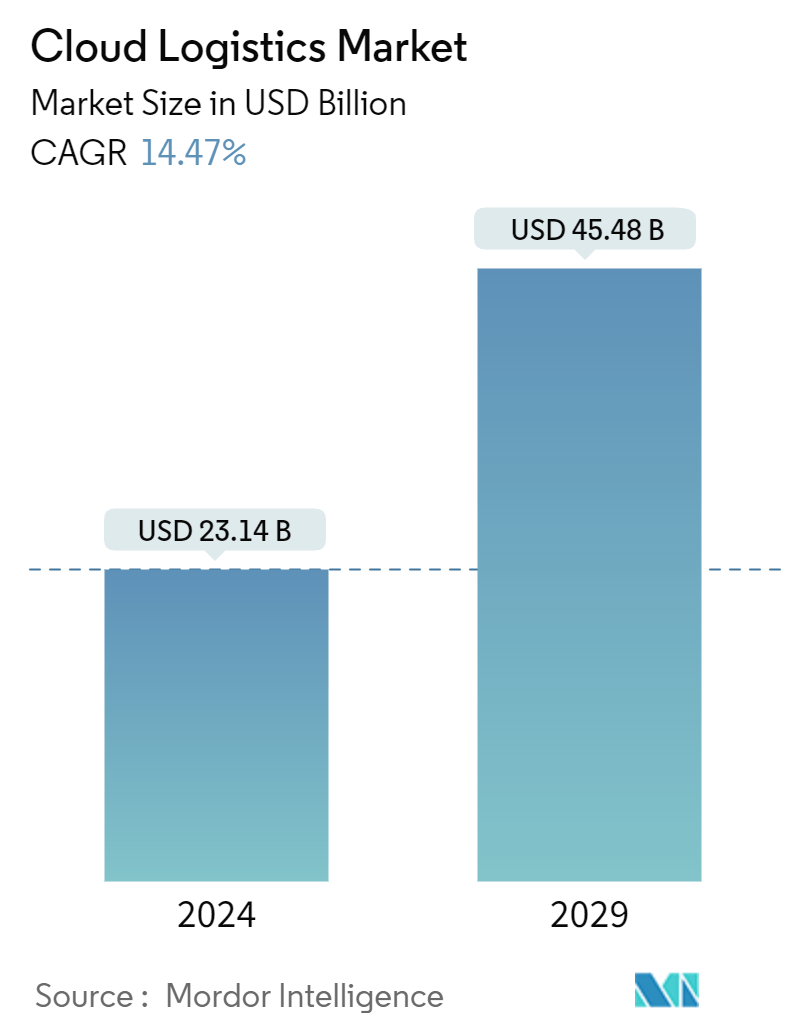Market Size of Cloud Logistics Industry

| Study Period | 2019 - 2029 |
| Market Size (2024) | USD 23.14 Billion |
| Market Size (2029) | USD 45.48 Billion |
| CAGR (2024 - 2029) | 14.47 % |
| Fastest Growing Market | Asia Pacific |
| Largest Market | North America |
Major Players
*Disclaimer: Major Players sorted in no particular order |
Cloud Logistics Market Analysis
The Cloud Logistics Market size is estimated at USD 23.14 billion in 2024, and is expected to reach USD 45.48 billion by 2029, growing at a CAGR of 14.47% during the forecast period (2024-2029).
- Cloud logistic solutions help businesses manage inventory, track shipments, and plan logistics, meeting the global demand for efficiency. These solutions also support customs compliance, customer service, invoicing, and specialized functions, such as transportation management for fleet and route planning, which are expected to drive market demand in the coming years.
- The increasing adoption of cloud logistic software for its flexibility, easy updates, and economic benefits supports the market's growth. The advantage of using cloud-based logistics software on a subscription basis is that users have a predictable monthly cost, which can help their OPEX estimations easily and support the market's growth worldwide.
- Businesses increasingly adopt cloud-based logistics solutions, leveraging software like a warehouse management system (WMS) in a software-as-a-service (SaaS) framework. This cloud iteration streamlines WMS installation and deployment, leading to fast implementation and significant cost efficiencies. Consequently, many enterprises embrace the cloud transformation to manage their inventory and facilitate universal data access, driving the market during the forecast period.
- However, cloud logistic solutions use cloud infrastructure for data storing and processing, increasing the risk of Data security in the business environment. This data breach risk can be critical for operational compliance and customer satisfaction. Compromised databases could lead to shipments being held at ports or refused entry. Additionally, customer data breaches can damage reputation and potential legal challenges for enterprises, restricting the adoption of cloud-based logistic solutions in the end-user industries worldwide, which could be a challenge for market growth.
- The macroeconomic trends, including the digital strategy adoptions among the end-user vertical after the covid-19 pandemic, supporting the growth of factory automation trends, and the increasing adoptions of analytics and IIoTs are supporting the demand for the market. The application of cloud logistic software in automating supply chain and logistics in line with the emergence of AI&ML and Cloud Computing technologies in logistic management in the post-COVID-19 pandemic has fueled the market growth.
Cloud Logistics Industry Segmentation
The cloud logistics market study tracks the revenue generated from the sale of cloud-based logistics platforms offered by the vendors to track and manage the logistics operations and provide visibility of in-transit goods/products.
The Cloud Logistics Market is Segmented by Organization Size (SMEs, Large Enterprises), End-User Industry (Consumer Goods and Retail, Healthcare and Life Sciences, Energy, Oil and gas, Manufacturing, Energy and power, and Other End-User Industries), and Geography.
The Market Sizes and Forecasts are Provided in USD for all the Above Segments.
| By Organization Size | |
| SMEs | |
| Large Enterprises |
| By End-user Industry | |
| Consumer Goods and Retail | |
| Healthcare and Life Sciences | |
| Oil & Gas | |
| Manufacturing | |
| Energy & Power | |
| Other End-user Industries |
| Geography | |
| North America | |
| Europe | |
| Asia Pacific | |
| Latin America | |
| Middle East and Africa |
Cloud Logistics Market Size Summary
The Cloud Logistics Market is poised for significant growth, driven by the increasing adoption of cloud-based solutions that offer flexibility, cost efficiency, and ease of updates. These solutions are essential for managing inventory, tracking shipments, and planning logistics, which are crucial for meeting the global demand for efficiency. The market is further bolstered by the shift towards software-as-a-service (SaaS) frameworks, which streamline installation and deployment processes, offering substantial cost savings. However, the reliance on cloud infrastructure raises concerns about data security, which could impact operational compliance and customer satisfaction. Despite these challenges, the market is supported by macroeconomic trends such as digital strategy adoption, factory automation, and the integration of analytics and IIoT technologies, which are enhancing supply chain automation and logistics management.
In the retail sector, the demand for cloud logistics solutions is fueled by the growth of e-commerce and the expansion of omnichannel sales channels. Cloud-based warehouse management systems are increasingly used to streamline inventory management, enhancing efficiency and reducing costs. The Asia-Pacific region, with its dynamic transportation and logistics landscape, is a key area for market expansion due to its role as a global supply chain hub. The region's developing economies and governmental support for manufacturing initiatives are driving the demand for outsourced logistics providers. Cloud service providers are also expanding their infrastructure in Asia to meet the rising demand, ensuring compliance with local data privacy laws. The competitive landscape is moderately fragmented, with numerous small and medium-sized providers partnering with industry leaders to enhance their offerings and drive market growth.
Cloud Logistics Market Size - Table of Contents
-
1. MARKET INSIGHTS
-
1.1 Market Overview
-
1.2 Industry Attractiveness - Porter's Five Forces Analysis
-
1.2.1 Bargaining Power of Suppliers
-
1.2.2 Bargaining Power of Consumers
-
1.2.3 Threat of New Entrants
-
1.2.4 Threat of Substitutes
-
1.2.5 Intensity of Competitive Rivalry
-
-
1.3 Regulatory Landscape
-
1.4 Assessment of Impact of macroeconomic trends
-
1.5 Ecosystem/Value Chain Analysis
-
-
2. MARKET SEGMENTATION
-
2.1 By Organization Size
-
2.1.1 SMEs
-
2.1.2 Large Enterprises
-
-
2.2 By End-user Industry
-
2.2.1 Consumer Goods and Retail
-
2.2.2 Healthcare and Life Sciences
-
2.2.3 Oil & Gas
-
2.2.4 Manufacturing
-
2.2.5 Energy & Power
-
2.2.6 Other End-user Industries
-
-
2.3 Geography
-
2.3.1 North America
-
2.3.2 Europe
-
2.3.3 Asia Pacific
-
2.3.4 Latin America
-
2.3.5 Middle East and Africa
-
-
Cloud Logistics Market Size FAQs
How big is the Cloud Logistics Market?
The Cloud Logistics Market size is expected to reach USD 23.14 billion in 2024 and grow at a CAGR of 14.47% to reach USD 45.48 billion by 2029.
What is the current Cloud Logistics Market size?
In 2024, the Cloud Logistics Market size is expected to reach USD 23.14 billion.

